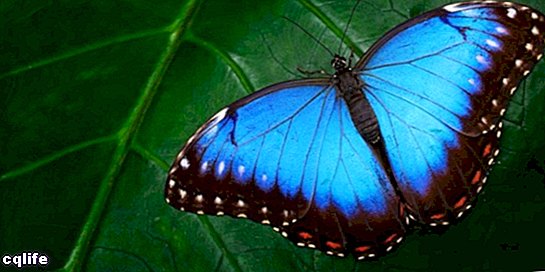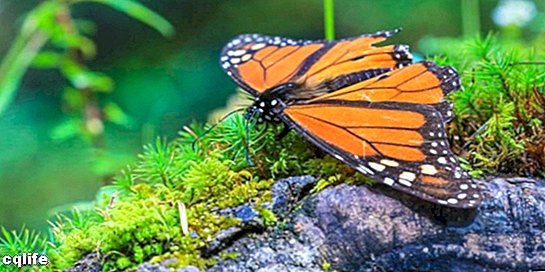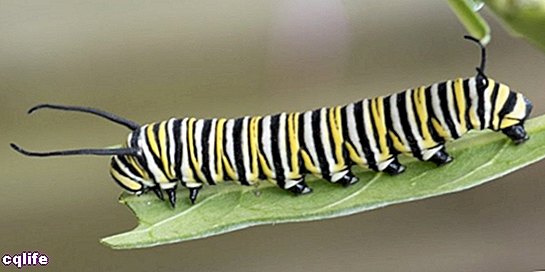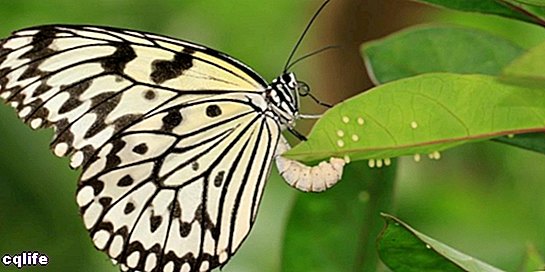- What are butterflies?
- Characteristics of butterflies
- Types of butterflies
- Butterfly habitat
- Butterfly feeding
- Butterfly life cycle
- Butterflies and moths
We explain everything about butterflies, their habitat, food and other characteristics. Also, its life cycle and differences from moths.

What are butterflies?
It is known by the popular name of butterfly to the different species extant lepidopteran insects (from the Greek lepsis, "Scales", and pteron, “Wings”), almost always flying, one of the most numerous among all the insects of the planet. Some species have habits diurnal and other nocturnal, but the nocturnal ones are the majority (and the least popular). There are about 165,000 different species of butterflies, classified into 127 families.
Butterflies have caught the attention of Humans since ancient times. In part this is due to the astonishing colors and patterns of daytime wings, and their attraction to flowers. In addition, their larvae, called caterpillars, provide food to numerous species of living beings on the nature.
On the other hand, it also presents a mystery since in its Lifecycle the metamorphosis plays a central role. Perhaps that is why the ancient cultures reserved an important place for them in their imaginary and their mythology.
In the various traditions, the butterfly usually represents beauty, purity or harmony, but also the change, the transition from something imperfect and temporary, to something wonderful and eternal. Many religions they saw in the fate of the butterflies an equivalent to the fate of the human soul. So much so that ancient greeks they called the butterfly psyche, term also used for the soul and for the conscience.
However, the diversity of names that butterflies receive in the West is enormous, and there does not seem to be much relationship between them. Its name in Spanish comes from the union of Mary, by the Catholic Virgin, and the verb to pose, probably the result of a children's or religious song of yesteryear.
But in English they are called butterfly, in German schmetterling, in Portuguese borboleta, in French papillon and in italian farfalla. Not to mention the specific names of each species.
Characteristics of butterflies

Broadly speaking, we can characterize butterflies as follows:
- Are arthropods and insects. That is, they have a segmented body with articulated limbs, with a chitin exoskeleton that covers it. In addition, being insects, they have three pairs of legs, a pair of antennae and two pairs of membranous wings, which in the case of butterflies are covered with colored scales.
- Day and night habits. Butterflies are flying animals, most of which are active at night. However, we know the diurnal species (properly butterflies) much better than the nocturnal ones (called moths).
- Complex life cycle. Before reaching adulthood, butterflies must hatch from an egg in the form of a larva or caterpillar, feed tenaciously until they have enough nutrients and, after a few weeks, weave a cocoon or pupa, within which metamorphosis will take place. Finally, the imago or flying adult will emerge from the cocoon.
- Migratory animals. Many species of butterflies travel hundreds of kilometers on their one-way trips. geography to another, according to climatic trends, to reproduce and spawn. Some of them are among the animal species that travel the longest on these trips, going from one continent to another.
- Coloring of the wings. The wings of diurnal species have very showy colors, with specific patterns, often designed as a camouflage method, with false eyes (to imitate a predator), or colors similar to those of other poisonous insects. These colors also serve to signal each other or for courtship.
- Sexual reproduction Y oviparous. Adult butterflies, like all insects, are sexed beings (female and male) and reproduce through the laying of eggs, from which the larvae emerge when they are fully formed.
Types of butterflies

The glossata butterflies have a spinnable proboscis.
Butterflies can be classified between diurnal and nocturnal, or using more specialized criteria, they can be organized into four different suborders, which are:
- Zeuglóptera. Where there are around 110 species of the most primitive Lepidoptera of all, endowed with jaws instead of proboscis, with a small size (5 to 12mm wingspan).
- Aglossata. Another order of primitive butterflies endowed with jaws and long labial palps, they have a unique family of insects known as Agatiphaga, in turn composed of two species from the South Pacific region (Australia and the Solomon Islands). They have a particularly low and slow metabolism, which allows them during their caterpillar stage to survive 12-year pauses.
- Heterobathmiin. The third set of primitive butterflies, possess diurnal habits unlike the previous two and still constitute a mystery for the zoology, since most of its species have not yet been described. They have wings of metallic colors and are typical of the south of South America.
- Glossata. The largest and most populated of all the suborders, where 99% of the current butterflies are, and includes all the families that have a coiled proboscis. Their main families are:
- Hesperiidae. Composed of more than 3,000 species of small butterflies, with a large head and a wide thorax, with very curved antennae and separated at the base.
- Lycenidae. Composed of almost half of the diurnal butterfly species (around 6,000 different species), they usually have small wingspan and bright colors on the upper side of their wings.
- Nymphalidae. Composed of medium to large-sized butterflies, with very bright colors and a pair of legs (front) shorter than the others.
- Pieridae. It is made up of thousands of species of small butterflies with white or yellowish wings, many of which deposit larvae dangerous for human crops.
- Papilionidae. Composed of the best-known species of butterflies in the world, with bright colors and diurnal habits, endowed with an extension of the wings at the bottom, like “tails”.
- Saturniidae. Composed of the largest nocturnal species of butterflies, many of which have false eyes (ocelli) on their wings, to mislead predators.
Butterfly habitat

Butterflies are terrestrial flying animals, living on all continental shelves except Antarctica. They tend to prefer environments with much vegetation, especially those that feed on nectar, since there are abundant flowers and feeding opportunities for caterpillars.
The highest concentration of species is found in the tropical forests and in the woods lowlands and foothills, although they can be found adapted to almost all habitats. There are also urban species, generally of moths, whose grayish or brown coloration adapts to the polluted and concrete-filled environment.
Butterfly feeding

During their larval or caterpillar stage, butterflies have a mandibular apparatus that with which they consume enormous amounts of organic material plant, such as leaves, stems, roots, fruits, and can constitute true pests in human plantations. Depending on the species, these caterpillars can even be carnivorous, feeding on other smaller insects.
Adult butterflies feed mostly on floral nectar and other liquid substances that they can suck or lick using their proboscis-shaped mouthparts (a kind of retractable tongue). That is why they frequent the flowers, thus carrying out an important work of pollination of the plants.
However, there are also species endowed with a chewing system that allows them to ingest pollen, spores of mushrooms and other similar substances, or species parasites that feed on the blood of higher animals. There are even species whose adult life is extremely short and frantically focused on reproductionSo they don't even have the means to feed themselves.
Butterfly life cycle

The life cycle of butterflies involves a complete metamorphosis (that is, the initial stages are nothing like the final stages) and comprises four different stages, which are:
- Eggs. The eggs of butterflies, like those of other insects, are small in size and are generally deposited in clusters by the female, in a location that varies according to the species. Some on plants, rocks, in the I usually or there are even a few species that must deposit them in the water, since their larvae are aquatic life. These eggs eventually hatch, releasing a single caterpillar from each.
- Larvae Called caterpillars, their primary function is to feed and gather enough nutrients to undertake the complex process of metamorphosis that leads to adulthood. Their habits, morphologies and behaviors can, however, vary enormously with the species. Some caterpillars are poisonous, others have colors that mimic those of poisonous ones, some are voracious eaters of plants and a few others prefer different food.
- Chrysalis Eventually, the larvae reach the level necessary to undertake a stage of profound changes, and for this they choose a suitable location, weave a cocoon with materials they segregate, and they lock themselves inside for the amount of time necessary to transform into adult butterflies. This stage is also known as "pupa".
- Imagos. When the metamorphosis is complete, the adult insect emerges from the chrysalis breaking its bark and waiting for its still wet wings to expand and dry enough to take flight. In this phase of adulthood, the butterfly will radically change its habits and modes of feeding, and will dedicate itself to reproduce to perpetuate the cycle.
Butterflies and moths
Night butterflies or moths are attracted to light.Commonly, we distinguish between daytime and nighttime butterflies, as if they were radically different species, when in fact they are not. For the diurnal ones we reserve the name of butterflies, while we call the nocturnal butterflies moths, sphinxes or peacocks, among others.
Although there are very numerous species that vary in coloration, shapes and habits, moths generally lack the vibrant colors and patterns like diurnal butterflies, and they tend to be brownish and dark. It is common for these insects to approach the lamps, attracted by their brightness that they confuse with that of the Moon, which they probably use to guide their flight.
